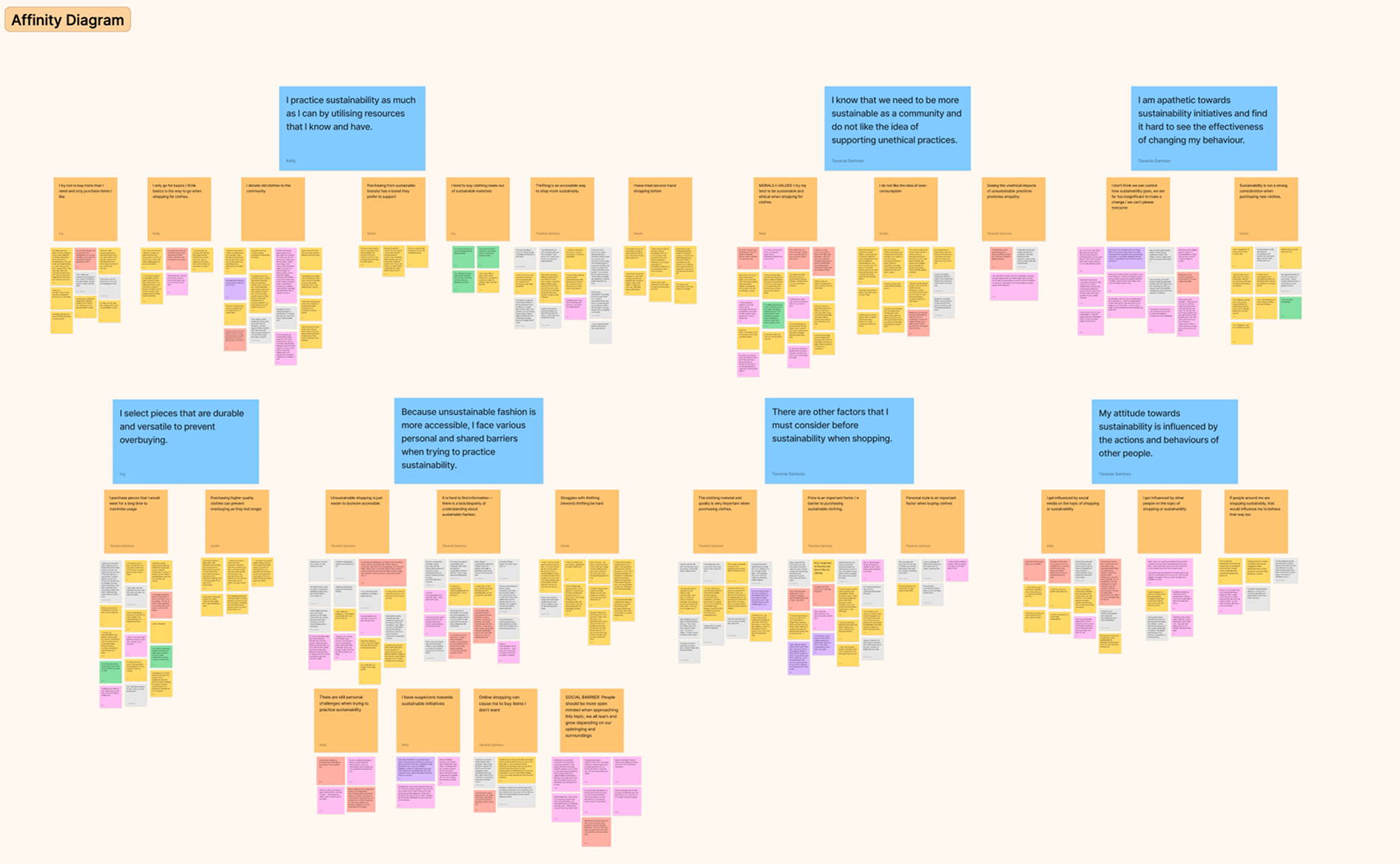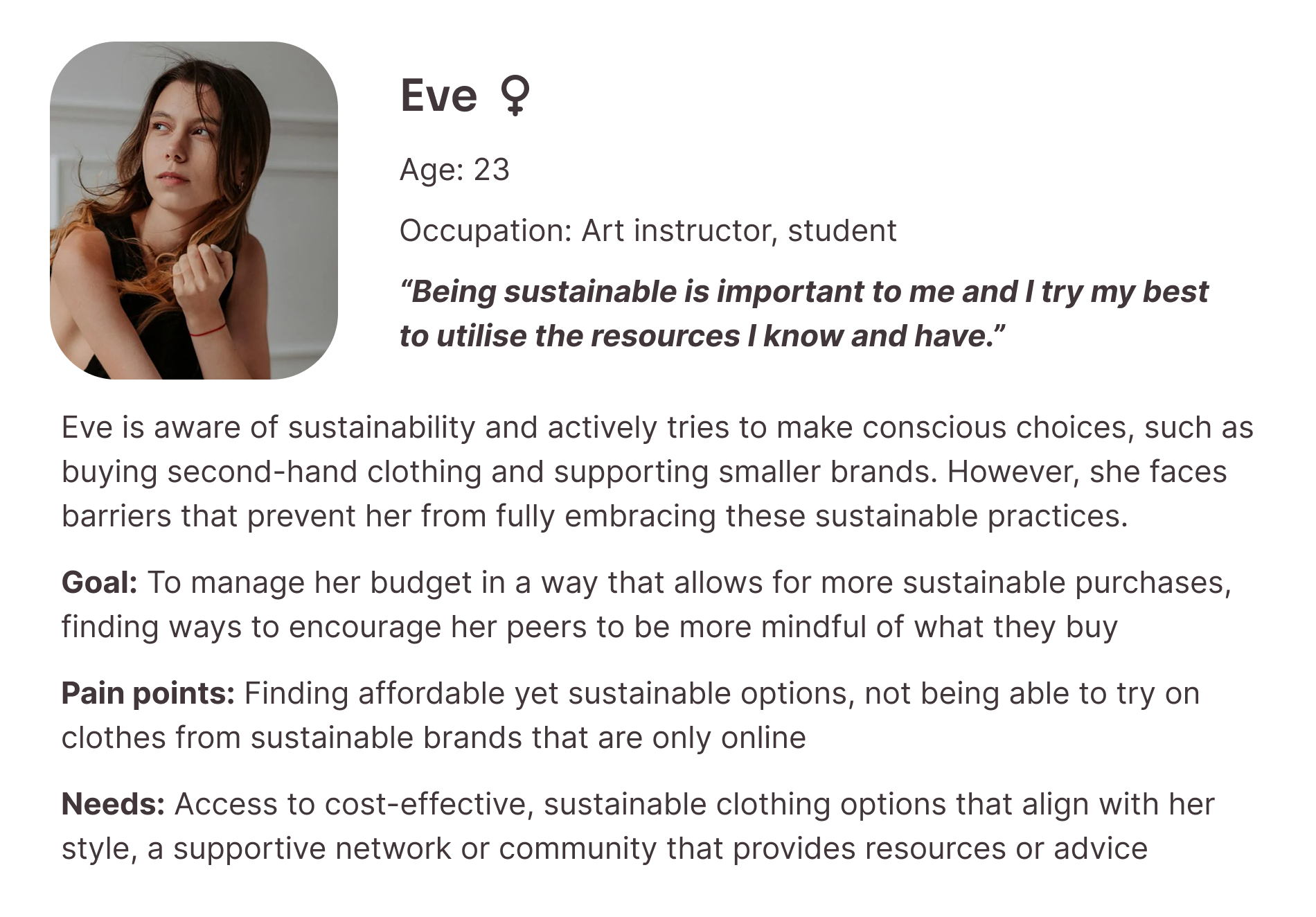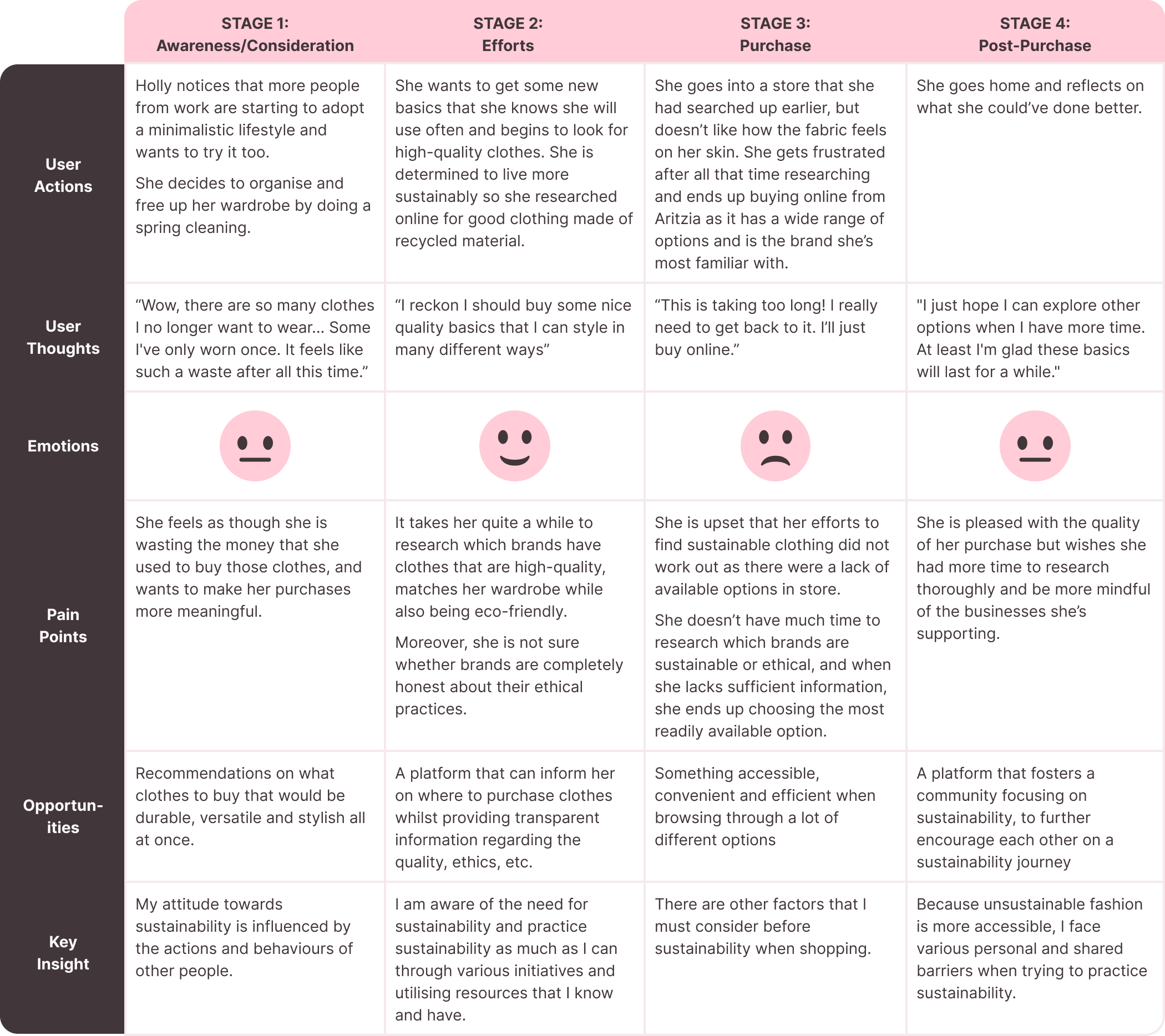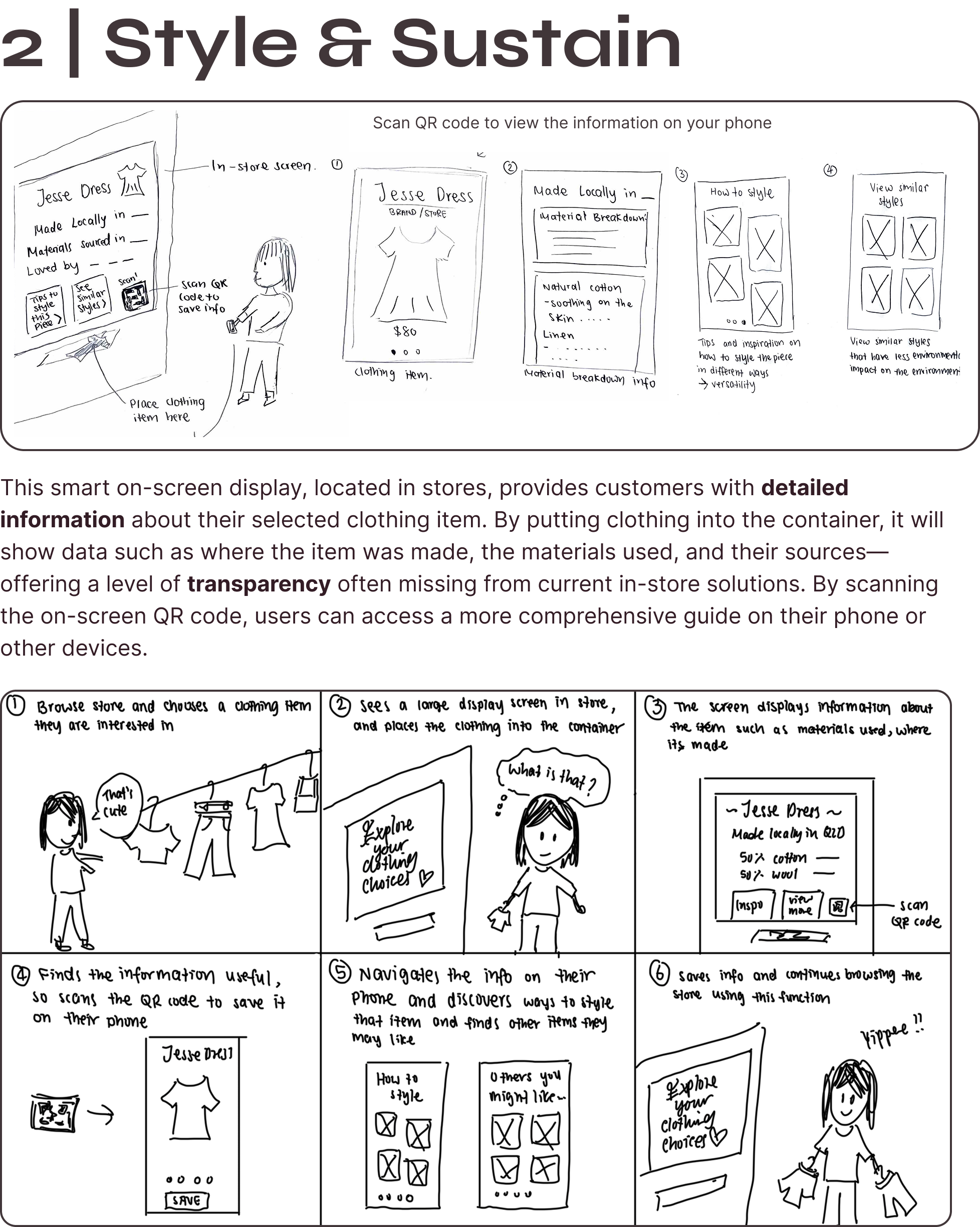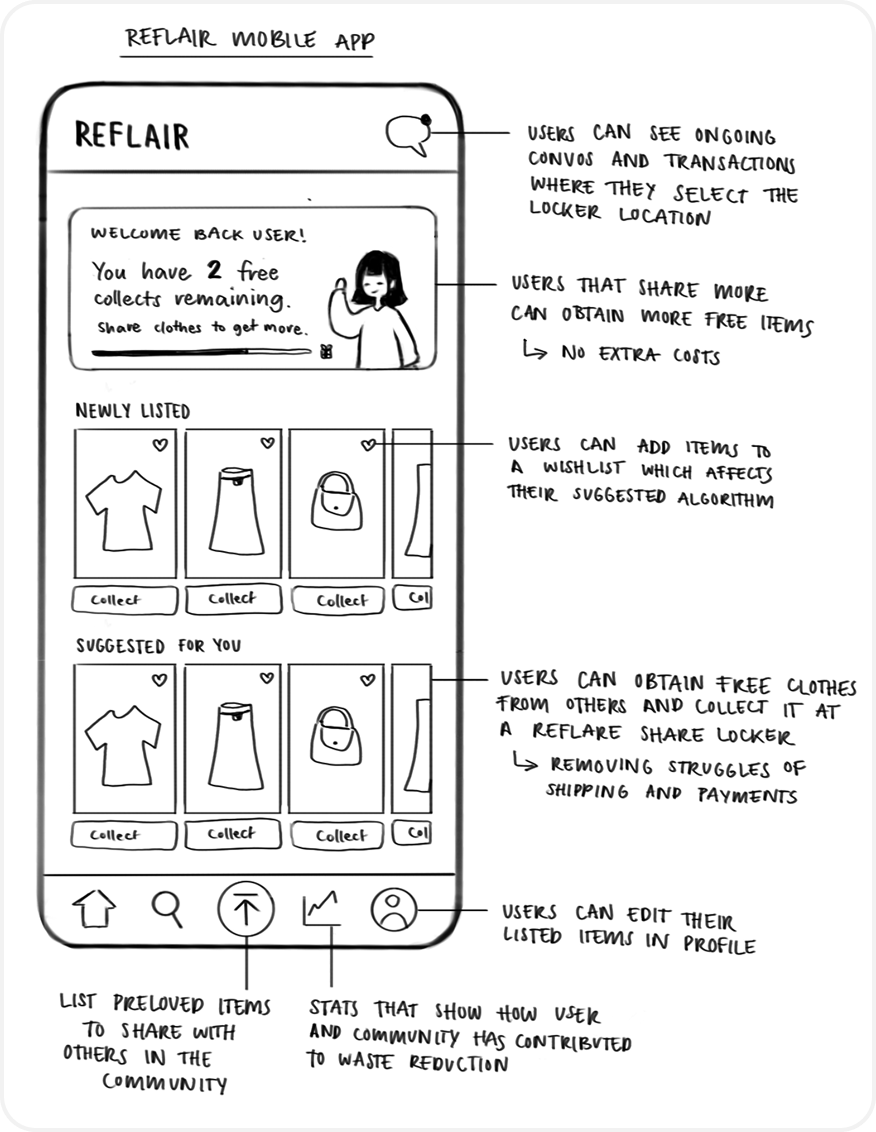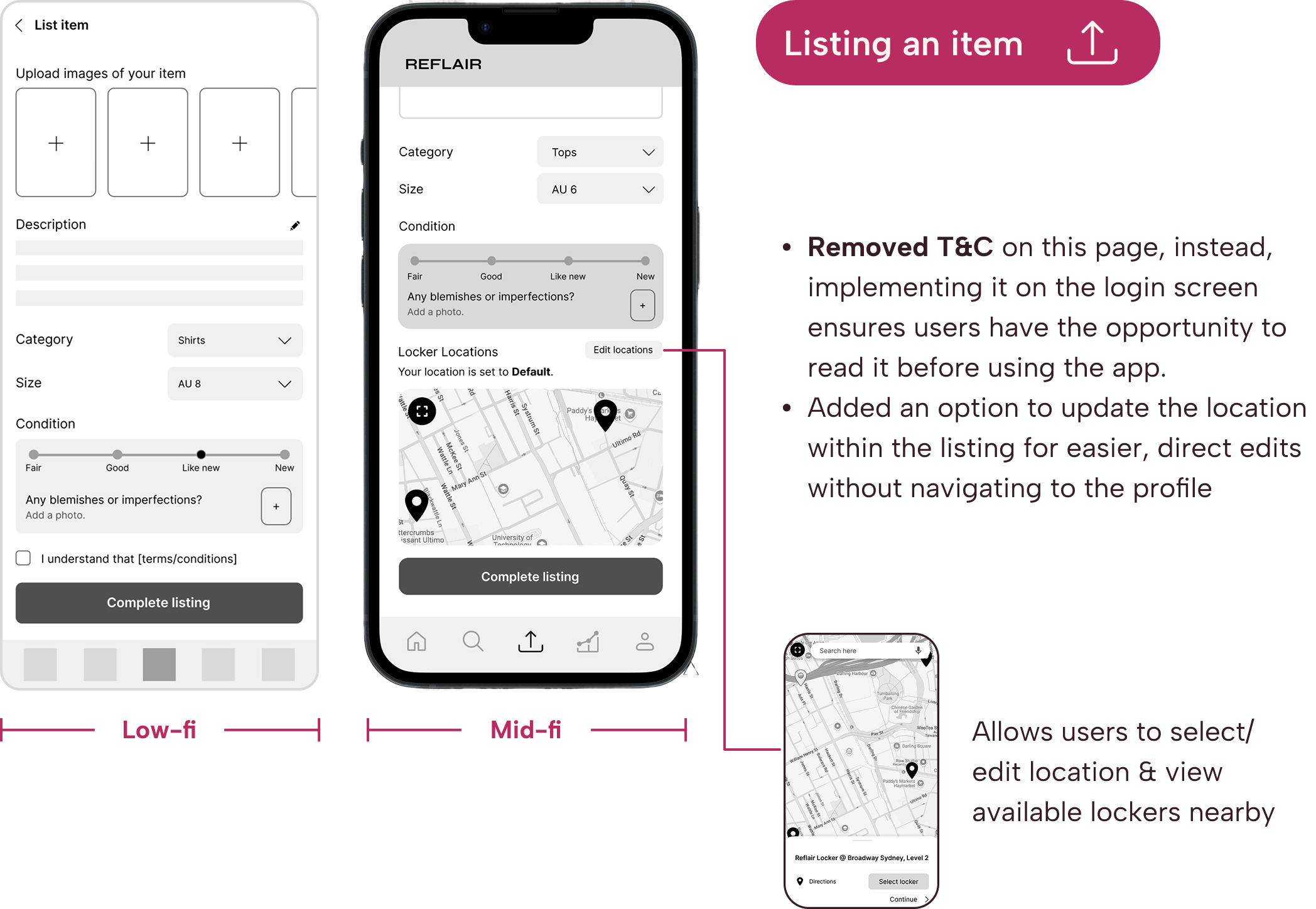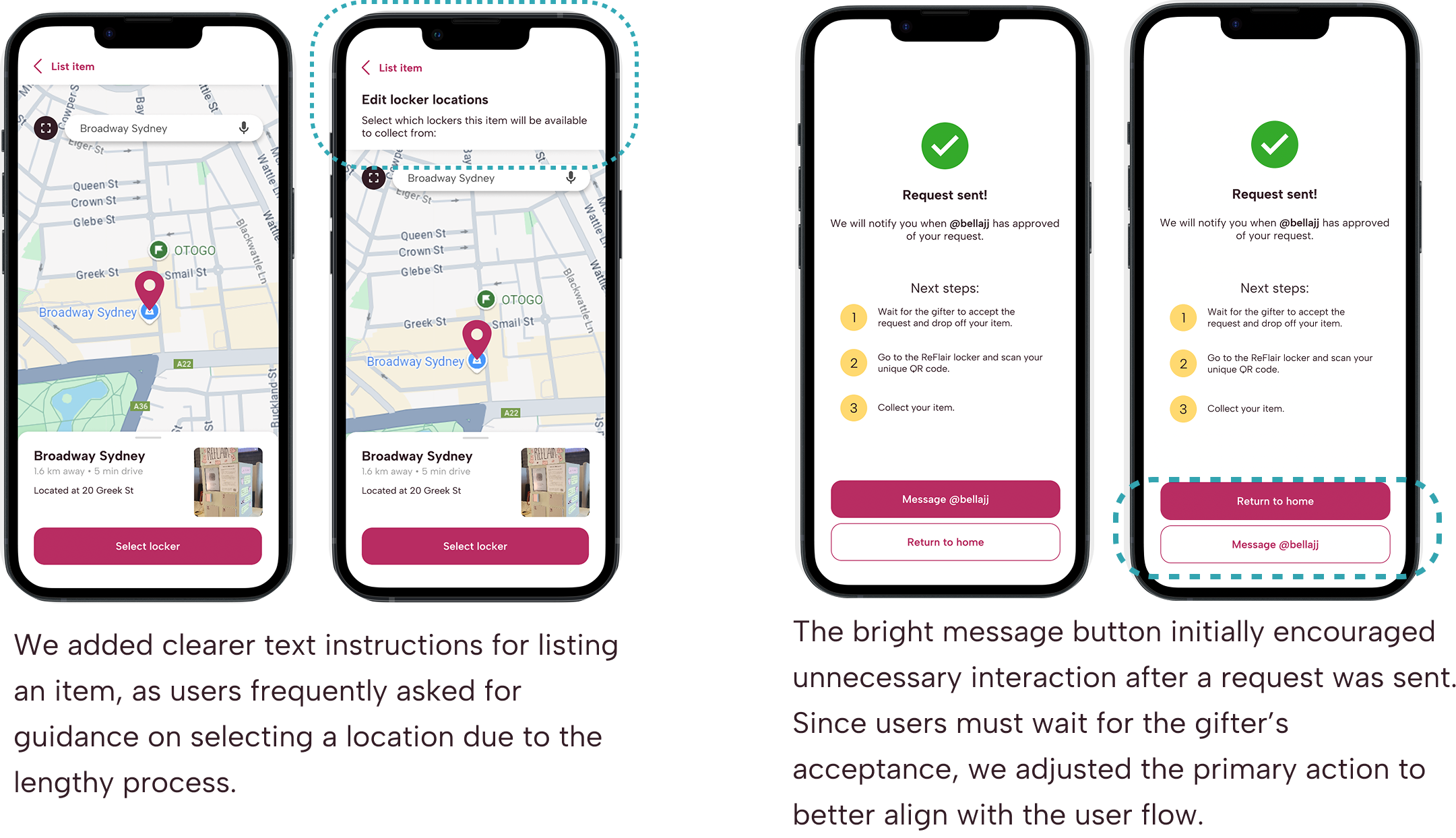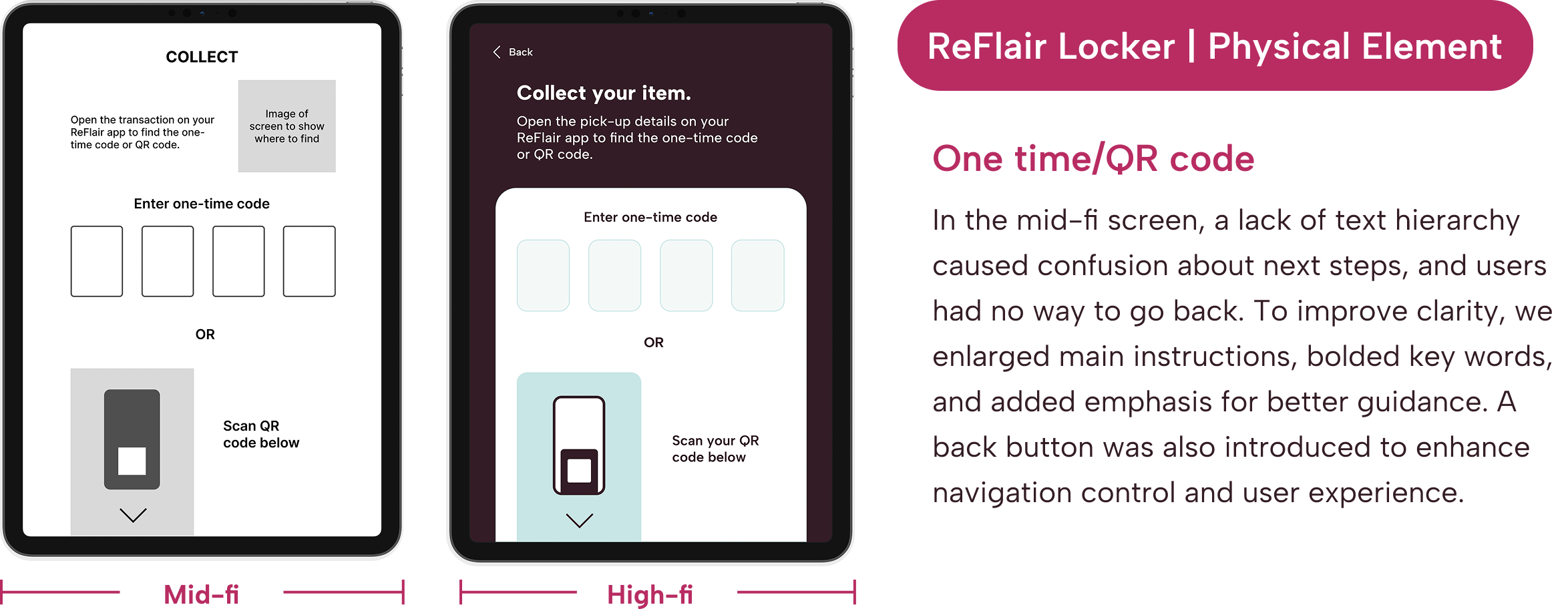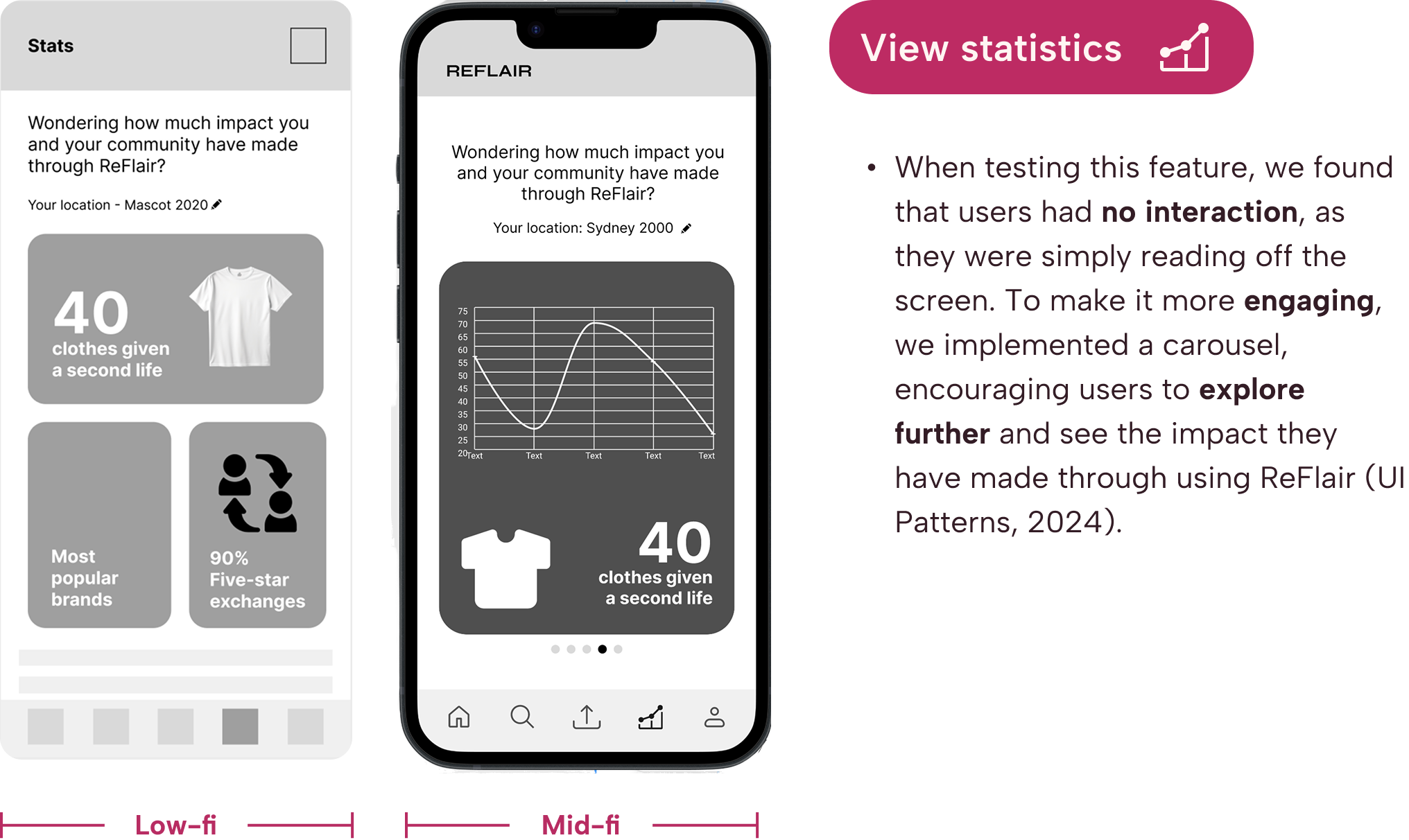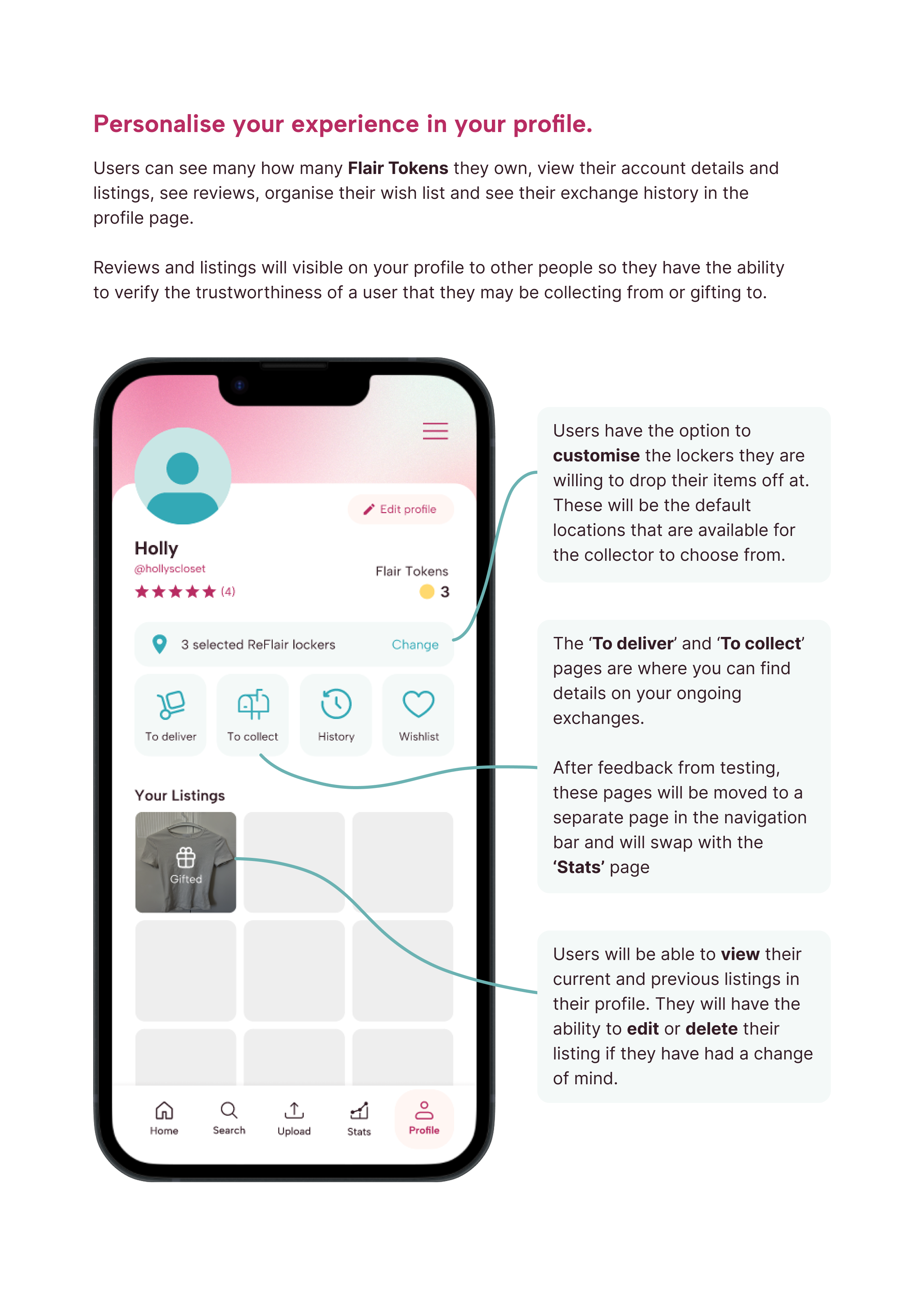
Overview
ReFlair is a community-driven clothing exchange platform that makes sustainable fashion accessible through a collect-and-drop-off locker system. By connecting individuals who want to give away clothing—ranging from second-hand to like-new items—with those looking to receive them, ReFlair encourages circular fashion consumption. This process is seamlessly automated through an interconnected mobile app and locker system, offering a convenient and simple way for users to participate in sustainability.
Our research aimed to address Sustainable Development Goal 12 (SDG 12), which promotes responsible consumption and production. The fashion industry remains a major contributor to global pollution, yet barriers such as cost, convenience, and lack of awareness prevent consumers from making sustainable choices. Our goal was to explore practical solutions that bridge the gap between sustainability awareness and action, leading to the creation of ReFlair as a user-friendly, scalable approach to circular fashion.
Duration | August 2024 - November 2024
Role | UX/UI designer, UX researcher
Tools | Figma, Blender
Team | Kelly Caviedi, Sarah Dang, Ivy Kwan, Tavania Santoso
Final solution
Prototype Experience
Problem Area
Context
Aligned with Sustainable Development Goal 12 (SDG 12), which promotes responsible consumption and production, ReFlair addresses the fashion industry’s environmental impact. As one of the world’s largest polluters, the industry contributes up to 10% of global CO₂ emissions (Climate Trade, 2023). While many individuals aim to shop sustainably, high costs, accessibility issues, and a lack of convenient solutions prevent widespread adoption.
Sustainable Development Goal 12 focuses on responsible consumption and production, aiming to reduce waste, promote resource efficiency, and encourage businesses and consumers to adopt environmentally conscious practices. Despite increased awareness of sustainability, the fashion industry remains the third-largest global polluter, contributing up to 10% of global CO₂ emissions (Climate Trade, 2023). Fast fashion's accessibility and affordability continue to drive high consumption and disposal rates, making it difficult for individuals to shift towards sustainable alternatives.
While many consumers express a willingness to adopt sustainable fashion, key barriers such as cost, availability, and lack of transparency limit widespread change. Nearly 60% of the 100 billion garments produced annually end up in landfills (McKinsey, 2018), and though 80% of Australians acknowledge they over-consume (Monash, 2023), only 54% would change their habits if they saw a direct personal impact (McCrindle, 2024). Additionally, 63% seek clearer information from brands regarding the sustainability of their products (WeWork, 2022), highlighting a gap between intention and action.
Addressing these challenges requires practical, accessible solutions that bridge the gap between sustainability awareness and real-world adoption, ensuring that responsible consumption becomes a feasible choice rather than an idealistic goal.
Research
Our research aimed to explore the factors influencing consumer engagement with sustainable fashion, focusing on behaviour, awareness, barriers to adoption, and market influence. We examined how consumers’ values align with their purchasing habits, the sources they trust for sustainability information, and the role of accessibility in adoption reluctance. Additionally, we investigated how retailers can better communicate sustainability benefits to drive consumer engagement.
To ensure a well-rounded understanding, we used triangulation to collect both qualitative and quantitative data, increasing the credibility of our findings. Our methodology included 110 questionnaire responses, 25 online ethnographic entries, and 12 interviews.
Data Analysis
After synthesising and analysing our key findings through a bottom-up affinity diagram, we identified 5 key insights that pinpointed the needs and problems of consumers, in relation to our research questions and objectives.
Key insights
Insight 1
Insight 2
Insight 3
Insight 4
Insight 5
There is an awareness of the need for sustainability, with limited efforts made to practice it through initiatives that are known and within reach.
73.7% of survey respondents are highly aware of sustainability in fashion, yet, 16% still dispose of clothing in the bin, indicating that efforts are often limited to accessible initiatives rather than broader, long-term sustainable practices.
There is a certain level of apathy towards sustainability initiatives, stemming from difficulty in perceiving how it would benefit them personally.
While awareness of sustainable fashion is growing, many believe individual actions are too insignificant to create real change, especially as large corporations prioritise profit over ethics. Some feel a strong stakeholder must lead the shift, while others remain disengaged, focusing on personal priorities over environmental concerns.
The higher level of accessibility of unethical fashion presents various personal and shared barriers to practicing sustainability.
The general availability and accessibility of fast fashion in shopping centres and online marketing offers more appeal as shoppers who sought out sustainable clothing were often met with limited size and style ranges, and uncomfortable fabrics or materials.
Other factors are prioritised over sustainability when shopping.
33.6% of survey respondents consider sustainability a very important factor when purchasing clothes, but 18% do not take sustainability into account at all when shopping. Reasons include prioritising price and availability, skepticism towards secondhand initiatives, and personal style preferences.
Attitudes towards sustainability are mostly influenced by the actions and behaviours of others.
Social media drives impulse fast fashion purchases, but personal networks have a stronger impact on sustainable habits; 59.1% of responders report that they are easily influenced by social media.
Based on primary research, the problem statement was validated and refined to better align with the needs of our user base, ensuring a more tailored and effective foundation for designing the solution.
People have differing levels of knowledge regarding slow, sustainable fashion but are reluctant to invest time into finding responsible options. This leads to overconsumption of unsustainable products, encouraging businesses to continue unethical practices, creating a cycle that's hard to break without real, actionable solutions.
Personas
After refining our problem statement to accurately reflect the key insights gained from our research, we developed 3 key personas that represented the diversity of our target audience and allowed us to understand the range of needs that must be catered to. The personas are differentiated by their perspectives, attitudes, and approaches to sustainability, particularly in how it influences their daily routines.
When addressing our problem area, we focused on our persona, Holly, to guide our concepts and direction. Her experience was further synthesised and visualised in a user journey map.
Ideation
After identifying key insights and personas, we began ideation, focusing on user needs, behaviours, and pain points. Using Crazy 8’s, we rapidly generated creative ideas, then refined and sketched the most promising concepts. To determine the most effective solution, we applied a concept decision matrix, evaluating each idea based on user needs, utility, and viability.
How did our chosen and reworked concept addresses our key insights?
1 Provides an easy and convenient method for those that are aware of sustainability and creates an incentive for those that are less inclined to shop from ‘eco-friendly’ brands.
2 Including a stats page will allow the user to see the impact of the community’s efforts and how much waste has been reduced.
3 Lockers are placed in convenient locations and users are able to browse a variety of styles and sizes through the app, improving accessibility of thrifting.
4 Users still have the freedom to look for items in their styles, sizes and preferred materials without needing to spend more money.
5 Public presence and community initiative - invites others in the community to participate in sustainable practices.
Low-fidelity to mid-fidelity
We followed an iterative prototyping process, beginning with sketches to visualise the interface flow and features. Low-fidelity wireframes were then developed, accompanied by guerrilla testing to identify usability issues early. This efficient approach uncovered navigational challenges, which we addressed in the mid-fidelity wireframes.
Mid-fidelity user testing
We conducted usability testing with 7 participants, including tutors, during a User Testing Fair, selecting individuals with diverse backgrounds in sustainability awareness and fashion interest. Users completed 4 tasks divided into Collector’s and Gifter’s Perspectives to assess system clarity and interaction flow. The think-aloud method helped evaluate usability in real-time.
Following the test, 6 participants completed SUS surveys, providing an average usability score of 80%, while our tutor conducted two heuristic evaluations, offering expert insights into both user perspectives. A post-test feedback session gathered qualitative insights, helping refine ReFlair to better align with user expectations.
Data analysis
Audio recordings were transcribed and analysed using an affinity diagram, grouping themes, patterns, and pain points for actionable design changes. Although testing covered both collector and gifter perspectives, common usability concerns emerged, particularly in navigation, visibility, and transaction clarity.
Key findings and prioritised changes
sers struggled with navigation due to low visibility of key features, prompting layout adjustments and the addition of an ‘Orders’ tab. Concerns around locker security and user trust highlighted the need for clearer feedback cues and stronger profile credibility. Confusion about Flair tokens revealed the need for improved onboarding to better align with user expectations
Mid-fidelity to high-fidelity
Further high-fidelity iterations
After making changes based on feedback from the user testing fair (mid-fi to high-fi), it was crucial for us to conduct a final round of user testing to ensure that our adjustments effectively addressed user concerns. This final testing phase allowed us to validate the usability of the updated design.
Prototype and User Testing
Final Concept Overview
Reflection
To stay on track, we established clear deadlines and defined team responsibilities, ensuring steady progress. Weekly in-person and remote meetings kept us accountable and cohesive, with deadlines set realistically to accommodate unforeseen delays. This structured approach allowed us to iterate, evaluate, and refine ReFlair to align with user needs while also producing a demo video showcasing key features and interactions. Effective time management and organisation helped us prioritise tasks efficiently, completing all planned development phases.
Future steps
Future iterations of ReFlair will focus on security, accessibility, and user experience. To prevent misuse, measures such as locker sensors or photo evidence requirements could ensure items are placed correctly. Enhanced accessibility features, including audio cues in lockers, could assist visually impaired users, while automated reminders would help manage item collection timelines. Expanding locker networks through partnerships with local businesses and thrift stores could increase accessibility, and additional eco-friendly incentives—such as extra Flair Tokens for donating sustainable or high-demand items—could further encourage participation.

